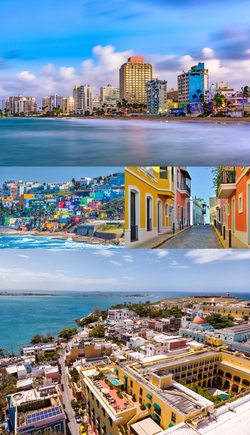Porto Leste
This article is incomplete because it is pending further input from participants, or it is a work-in-progress by one author. Please comment on this article's talk page to share your input, comments and questions. Note: To contribute to this article, you may need to seek help from the author(s) of this page. |
Porto Leste
Lakeniba (Nati) | |
|---|---|
 Clockwise from top: Porto Leste Skyline; A Lestean Anaroço; The Old Town of Porto Leste from Fortaleza de Sotiras; Distrito do Mundo, a social housing project converted from an old favela | |
| Etymology: Lusitan for "East port" | |
| Country | Maracao |
| Province | Aldiriz |
| Town | Porto Leste |
| Founded | 1549 |
| Government | |
| • Mayor | Amanda Mendez (FRL) |
| Area | |
| • Total | 819.67 km2 (316.48 sq mi) |
| • Water | 213.43 km2 (82.41 sq mi) |
| Elevation | 0–26 m (0–85 ft) |
| Population (2017) | |
| • Total | 1,476,188 |
| • Density | 1,800/km2 (4,700/sq mi) |
| Demonym | Lestean |
| Time zone | UTC+12 (Central Asterian Time) |
Porto Leste (/'pɔːrtoʊ 'lɛst/ or /'lɛsteɪ/; Lusitan pronunciation: ['poɾtu 'lɛʃ.tɨ]; Nati: Lakeniba) is the capital and most populous city in Maracao. Within Maracao, the city is often referred to as simply Porto, and is part of Porto Leste Town, which itself is part of the eastern Aldiriz Province. Porto Leste is the centre of most institutions of the Maracan government and diplomatic representations from other countries. With a population of 1.47 million in 2017, it is the second largest urban settlement in the Arucian - behind Découverte in Sanslumière.
Porto Leste was founded by Lusitan settlers in 1549, and quickly became the most populous city on the island due to its port and proximity to the eastern plantations. It was designated officially as a city in 1581 and as capital of the Maracao colony in 1606. Porto Leste grew wealthy through the exports of sugar and exotic fruits back to Euclea as part of the Asterian Slave Trade. Salvatore Renzi delivered the Porto Leste Declaration within the city when Marirana seized the island in 1821. The city also served at the centre of the reign of Adelmar I, however many of his palaces were abandoned during the Great War. The city suffered minor damage during the war and subsequent Liberação revolt, but remained mostly in tact.
The city is renowned for its exquisite colonial-era architecture that adorns the Old Town, with many buildings built in the 16th and 17th centuries. Its colourful, narrow streets, named Anaroço, have also gained notoriety for their uniqueness, and are a defining symbol of the city. Elsewhere, socialist influence can be seen in the converted favelas of the Distrito do Mundo, which were converted into social housing in the 1980s and 1990s. Porto Leste serves as Maracao's primary tourist destination, and receives most air and sea traffic for cities such as Covancas. In 2018 alone, around 1.5 million tourists visited Porto Leste.